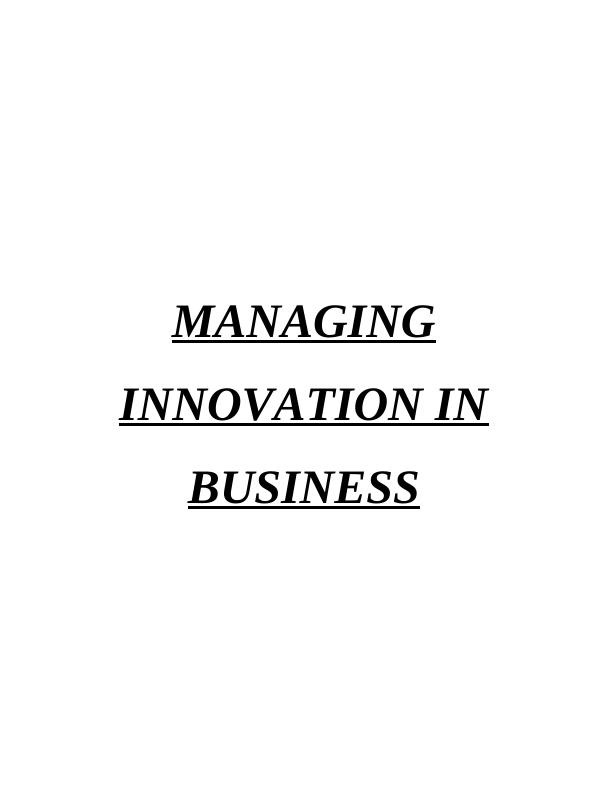PESTLE Analysis of Marks & Spencer
Added on 2021-01-01
11 Pages3116 Words375 Views
MANAGINGINNOVATION INBUSINESS

Executive SummaryThis report explores the concept of innovation and the importance of bringing aboutinnovation at rapid intervals to ensure growth and expansion of company. The present report isbased on Marks & Spencer which provides clothing, accessories, food and home products. Themain purpose of this organisation is to ensure maximum customer satisfaction through provisionof high quality and innovative products which match the requirements and demands ofconsumers. This report is categorised into three parts. The first part includes the innovationhistory of Marks and Spencer and reveals that this organisation has been an epitome ofinnovation over years. PESTLE analysis is conducted to ascertain the factors that act as driversfor innovation. The second part includes the overall existing performance of company along withthe capabilities which foster entity to bring innovation. This reveals that organisation is capableof making use of various latest trends and techniques prevailing within retail industry. Lastly, theoverview of retail industry has been described to gain an insight into growth of industry andscope for companies to indulge in innovation.It has been evaluated that M&S is engaging in innovative practices to continuouslydesign and develop products that meet requirements of customers. It has been found out thatcompany has developed a 5 year transformation programme which aims at enhancing the salesans profits of enterprise.It has been recommended that company should make use of Emotient to gain knowledgeof consumer sentiments regarding products and services delivered by entity.

Table of ContentsExecutive Summary.........................................................................................................................2INTRODUCTION...........................................................................................................................1The Organisation and its Innovation History..............................................................................1The Organisations existing Innovation Performance and Capabilities.......................................4The Industry................................................................................................................................5CONCLUSION................................................................................................................................7REFERENCES................................................................................................................................8

INTRODUCTIONInnovation can be referred to as a process wherein a new product is developed owing tothe use of a unique technique or value addition is done in case of existing goods so as to makethem compatible with the changing customer needs and preferences (Helper and Henderson,2014). The following report is carried out upon Marks & Spencer which is a British retailerdealing in food, clothing, accessories, home products etc. this company is headquartered inLondon, United Kingdom. This report explores the innovation history of organisation. Besidesthis, it talks about existing innovation performance of company along with the capabilities tobring about innovation in future. Further, it includes the industry overview.The Organisation and its Innovation HistoryMarks & Spencer is an international multinational brand which came into force in 1884when Michael Marks who was a Polish refugee initiated a market stall within Leeds under theslogan, “Don’t ask the price, it’s a penny”. It has 980 stores across United Kingdom out of whicharound 615 only deal in distribution of food items as of now.Exploring the innovation timeline of company, it can be said that this organisationtransformed a lot over the last century. Marks & Spencer opened its first store within Leeds in1904. The 1920's saw the adoption of revolutionary policy by M&S which fostered directpurchase through suppliers. In the year 1931, this organisation introduced a food unit which soldproduced as well as canned items. By the end of 1933, a welfare service was established foremployees which rendered facilities such as subsidised canteen, pension, camping holidays,healthcare and dental amenities etc. (Noble, 2017).Continuing the trend, Marks & Spencer became the first British retailer to well establishtheir own research laboratory in the year 1934 which facilitated in pioneering new fabrics. In theyear 1948, company came up with Food Technology Department so as to build effectiverelationship with farmers, producers and suppliers and closely working with them. In 1954, M&Sresearch lab took a survey upon women' leg sizes and resulted in development of a enhanced andunique sizing procedures for stockings (Dodgson, 2018). By the end of same year, Marks &Spencer’s “Operation Simplification” strived to significantly reduce internal documentation by1

End of preview
Want to access all the pages? Upload your documents or become a member.
Related Documents
Managing Innovation in Businesslg...
|11
|2992
|41
Managing Innovation in Businesslg...
|13
|2720
|1
Managing Innovation in Businesslg...
|12
|3209
|96
Managing Innovation: Importance and Impact on Marks and Spencerlg...
|12
|3260
|94
Managing Innovation in Businesslg...
|10
|2625
|74
Managing Innovation in Business (Distinction Criteria) - BM627lg...
|14
|3468
|446
